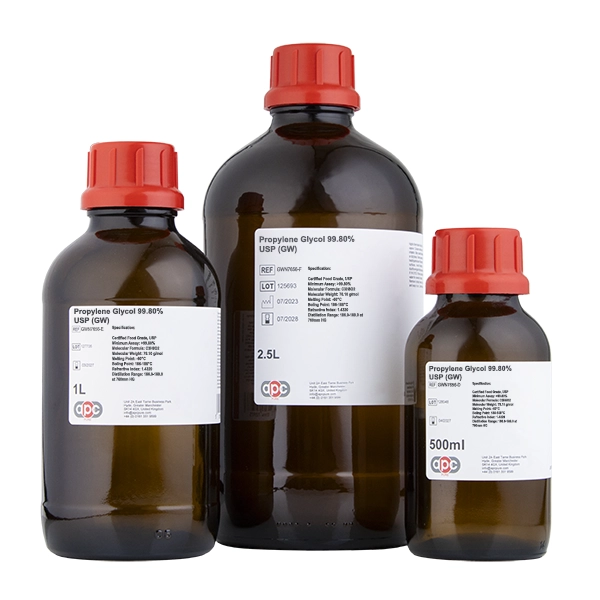Propylene Glycol 99.80% USP

£5.95 to £131.95
To see other pack sizes, select from drop down
| Variation ID | Pack Size | List Price | Qty | ||
|---|---|---|---|---|---|
| photo_camera | 100ml Letterbox
ECE7656-B |
£5.95 | |||
| photo_camera | 250ml Letterbox
ECE7656-C |
£6.75 | |||
| photo_camera | 500ml
ECE7656-D |
£8.55 | |||
| photo_camera | 1L
ECE7656-E |
£11.95 | |||
| photo_camera | 2L
GPC7656-2E |
£19.37 | |||
| photo_camera | 2.5L
ECE7656-F |
£22.45 | |||
| photo_camera | 5L
ECE7656-G |
£39.25 | |||
| photo_camera | 10L
ECE7656-I |
£68.95 | |||
| photo_camera | 25L
ECE7656-K |
£131.95 |
What is Propylene Glycol? It is a viscous, colourless liquid. It is almost odourless and has a faintly sweet taste. Its chemical formula is C3H8O2. As it contains two alcohol groups, it is classified as a diol. An aliphatic diol may also be called a glycol. It is miscible with a broad range of solvents, including water, acetone, and chloroform. In general, glycols are non-irritating and have very low volatility.
Consistent Quality: We provide only high-quality Propylene Glycol 99.80%, meeting the standards of USP, ensuring reliable and consistent performance for all applications.
Shipped from Manchester, UK Facility: Sourced and bottled in non-toxic, chemical-resistant containers to ensure safe handling and preserve product quality during transport.
Frequent Uses
Polymerisation
Forty-five percent of propylene glycol produced is used as a chemical feedstock for the production of unsaturated polyester resins. In this regard, propylene glycol reacts with a mixture of unsaturated maleic anhydride and isophthalic acid to give a copolymer. This partially unsaturated polymer undergoes further crosslinking to yield thermoset plastics. Related to this application, propylene glycol reacts with propylene oxide to give oligomers and polymers that are used to produce polyurethanes.
Paints
Used in water-based acrylic architectural paints to extend dry time which it accomplishes by preventing the surface from drying due to its slower evaporation rate compared to water.
Food manufacturing
In regulated amounts, it is designated as safe for food manufacturing as an anticaking agent, emulsifier, flavour agent, humectant, texturiser, stabiliser, solvent, antioxidant, antimicrobial agent, and thickener.
Antifreeze
Frequently used as a substitute for ethylene glycol in low toxicity, environmentally friendly automotive antifreeze. It is also used to winterise the plumbing systems in vacant structures.
Ecigs
Propylene glycol, vegetable glycerin, or a mixture of both, are the main ingredients in e-liquid used in electronic cigarettes. They are aerosolised to resemble smoke and serve as carriers for substances such as nicotine and flavourants.
- Ecigs
- Hand Sanitisers
- Medicines
- Food Colourings
- Cosmetics
- Shampoo
Certified Food Grade, USP
Assay: > 99.80%
Molecular Formula: C3H8O2
Current USP:-
Acidity: < 0.20ml
Chlorides: < 70ppm
Residue on ignition: < 0.0070%
Specific gravity at 20˚C: 1.035—1.037
Sulphate: < 60ppm
Water content: < 0.200%
ID test A, matches IR scan: Pass
ID test B, limit of Ethylene Glycol: Pass
ID test B, limit of Diethylene Glycol: Pass
ID test C, matches GC scan: Pass
Current EP:-
Acidity: < 8.3ml
Boiling point: 184—189˚C
Clarity: Pass
Colour: Pass
Melting point: 121—128˚C
Oxidising substances, 0.05M Sodium Thiosulphate: < 0.20ml
Reducing substances: Pass
Refractive index at 20˚C: 1.431—1.433
Relative density at 20˚C: 1.035—1.040
ID test D: Pass
Ethylene Glycol: < 0.0620%
Diethylene Glycol: < 0.10%
Water content: < 0.200%
Current JP:-
Sulphated Ash: < 0.0100%
Residue on ignition, FCC: < 0.0070%
Acidity: Pass
Arsenic: < 2.0ppm
Chlorides: < 0.007%
Distilling range, 184—189˚C: < 95%vol
Glycerine (odour): Pass
Heavy metals: < 5.0ppm
Melting point: 174—178˚C
Odour: Pass
Residue on ignition : < 0.0050%
Specific gravity at 20˚C: 1.035—1.040
Sulphate: < 0.002%
Water content: < 0.500%
Current FCC:-
Assay: > 99.80%
Acidity: Pass
Appearance, clear & colourless: Pass
Distillation, IBP: > 185.0˚C
Distillation, DP: < 189.0˚C
Lead: < 1.0ppm
Identification, matched IR scan: Pass
Specific gravity at 20˚C: 1.035—1.037
Water content: < 0.200%
Final testing requirements:-
Acidity as Ascetic Acid: < 0.0020%
Appearance, clear & free from suspended matter: Pass
Chlorides: < 1.0ppm
Colour: < 10 Pt-Co
Dimer, Trimer & higher Polymers: < 0.100%
Ethylene Glycol: < 0.0080%
Diethylene Glycol: < 0.0080%
Iron: < 0.30ppm
Odour, practically odourless: Pass
Specific gravity at 20˚C: 1.0376—1.0389
Cas Number: 57-55-6
Einecs Number: 200-338-0
HS Code / Commodity Code: 2905320000
Hazard Phrases: H0001




